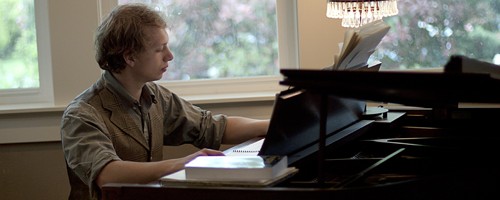In case you’re in the neighborhood…
Winter break is a great time to travel–to the ski slope, to Hawaii or to your parents’ house to do some laundry. But it’s always nice to have other options, just in case of a flight layover, a sudden thaw or the need to escape Mom’s “what are you going to do with an art history degree?” questions. So, here’s my top ten places to see art that don’t involve museum admission:
Southwest
1. Walter De Maria’s Lightning Field (1977) occupies a high desert plateau in southwestern New Mexico. Four hundred stainless-steel poles rise from the earth in a measured grid one mile by one kilometer. Visitors are encouraged to walk among the poles, appreciate the landscape and its alteration and hopefully observe a lightning strike or two. Even without the electric effects, De Maria’s work is a great opportunity to observe the collision of precision and the chaos of nature. (www.lightningfield.org)
2. If Salt Lake City is on your itinerary even as a flight layover, have a look for Robert Smithson’s Spiral Jetty in the Great Salt Lake. Constructed in 1970, the jetty is occasionally visible during times of low water. Smithson created the work from local basalt, intentionally contrasting the black of the rock with the red of the sea-monkey-infested water. Over time the edges of the jetty have become white with crystallized salt. Standing on the edge of the lake is very different than seeing Spiral Jetty from above as it is usually photographed. One can appreciate the desolate nature of the area, the smell of the lake and the sculptural aspects of Smithson’s work. (www.spiraljetty.org)
3. In Houston, Mark Rothko’s vision of unification of art and spirituality was realized by Dominique and John de Menil. The Rothko Chapel is open to visitors of all beliefs 365 days every year. The low concrete building is announced by Barnett Newman’s Broken Obelisk and has hosted many distinguished visitors since its 1971 dedication, including Nelson Mandela and the Dalai Lama. Inside, the open floor plan allows visitors to meditate while completely surrounded by Rothko’s fields of colors. Rothko hoped to evoke strong emotional reactions with his work, once saying “the people who weep before my pictures are having the same religious experience I had when painting them.” (www.rothkochapel.org)
Northwest
4. Sea-Tac Airport, strangely enough, is a great place to experience works by local and internationally known artists. In the ticketing circus of the main terminal is Louise Nevelson’s Night Flight (1972), an assemblage of found objects painted black. In baggage claim (near Carousel 8), look for Norman Andersen’s Rainmaker’s Baggage, a noisy, twirling sculpture of suitcases. Sea-Tac’s art committee attempts to engage as many senses as possible, installing six of Jim Green’s Talking Fountains throughout the terminals–although they look innocuous, be prepared for an extra loud drinking experience. In total, Sea-Tac displays over 100 artworks and counting. Keep your eyes (and ears) open as you look for your gate (www.portseattle.org/seatac/art/ongoing.shtml).
5. When en route to your ski holiday in B.C., pull off at Bellingham to stretch your legs with a quick art hike around the campus of Western Washington University. Started in 1957, the Outdoor Sculpture Collection includes some very recognizable names and more than 100 pieces. Donald Judd is represented by a large divided cube, Mark di Suervo’s For Handel towers over the rehearsal hall and Nancy Holt’s Stone Enclosure: Rock Rings will change the way you see the sky. Download a walking-tour map before you go, and don’t miss anything (westerngallery.wwu.edu/sculpture.shtml).
Across the country
6. The large clothespin in middle of Philadelphia is my favorite–appropriately titled Clothespin, this monster dwarfs the competition at 45 feet tall. Claes Oldenburg and Coosje van Bruggen have been creating monumental sculpture from everyday media objects since 1971 and are included in most major museum collections. Fortunately, most of their work doesn’t fit inside, and is instead installed in conspicuous places a commentary on the design and beauty of the mundane, it’s an exercise in art vs. architecture, and sometimes it’s just a larger-than-life Swiss Army knife. Check out Oldenburg and van Bruggen in Las Vegas, Minneapolis, Los Angeles and Chicago to name a few (www.oldenburgvanbruggen.com).
7. Frank Lloyd Wright designed public and private buildings in 38 states. Although the most famous are Fallingwater in southwest Pennsylvania and the Guggenheim Museum in New York City, there are many other well-preserved examples of his genius. Wright created the Prairie style of architecture, and is credited with the development of such modern things as open floor plans. His designs for residences often included custom furniture and china designed to coordinate with the architecture. Many residences are still private, but with almost 500 buildings to his credit there’s lots of Wright to see–check out the All-Wright Site online for the definitive listing (www.geocities.com/soho/1469/flw.html).
Big cities
8. Chicago’s Millennium Park is the site of amazing pieces by artists Jaume Plensa and Anish Kapoor. The Crown Fountain designed by Plensa displays changing images of native Chicagoans on its 50-foot tall glass block screens. Recalling the gargoyles used to traditionally decorate fountains, the projections appear to be spouting water (at least in the summer–in the winter it would be a bit icy). Kapoor’s Cloud Gate is a seamless construction of stainless steel that reflects both the sky and city. Reminiscent of a blob of mercury (although a 33-foot tall blob), the sculpture is almost impossible not to touch (www.millenniumpark.org/artandarchitecture).
9. I know I said no museums, but what I really meant was no conventional museums. Every once in a while something like Pittsburgh’s Mattress Factory comes along–different and exciting, with no wall-mounted labels and framed oil paintings. The Mattress Factory is instead comprised of artist-installed rooms, entire mini-environments that invite the viewer to become part of the exhibit. Permanent spaces have been created by the likes of James Turrell and Yayoi Kusama, and guest artists are rotated through residencies every year (www.mattress.org).
10. Finally, New York. With so much art in such a small space, it’s a wonder that I’m even bothering to mention it. But Dia:Beacon isn’t in New York City. It’s a 90-minute drive (or train ride) north along the Hudson River. Why put a museum in such an out-of-the-way spot? Because floor space is cheaper–and Dia:Beacon uses lots of it (300,000 square feet!). In this five-football-field-size space are some of the most monumental and awe-inspiring sculptures of the 20th century. Richard Serra’s Torqued Ellipses, installations by Joseph Beuys, the spiders of Louise Bourgeois–they’re all here, permanently installed in dedicated galleries. Pick up a map at the front desk first (www.diacenter.org).
So there you go, 10 places to visit on your winter travels if you’re in the neighborhood. For those of us staying in Portland, please take a photo or two, and if you find an amazing work of art in a strange place, let me know–I can always use an excuse for a road trip.




